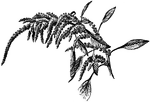Clipart tagged: ‘Amaranth’

Amaranth
"A genus of plants of the natural order Amaranthaceae. This order contains nearly 300 known species,…

Amarantus Caudatus
The common name of Amaranths caudates is love-lies-bleeding. The plant is tall, about three to five…

Amarantus Gangeticus
The Amaranths gangeticus plant is three feet tall or smaller, usually only one foot tall. The flowers…

Prickly Saltwort
Salsola kali. This plant is also called a Russian Thistle, Prickly Glasswort, Tumbleweed, and Glasswort.…

Weeds
"Four common weeds, the seeds of which are eaten by birds: a, amaranth; b, crab grass; c, ragweed; d,…